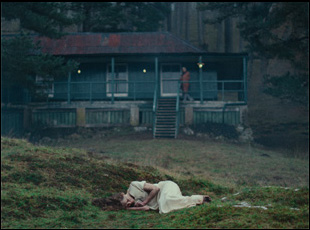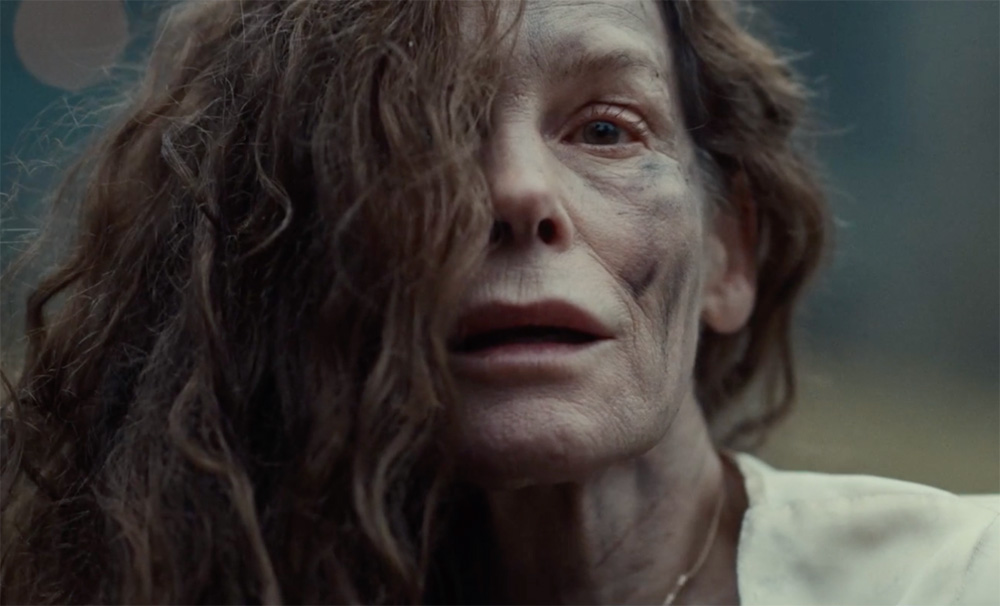“I was told this was a women’s retreat,” Veronica Ghent (Alice Krige) hisses as she enters a compound in the far reaches of the Scottish highlands in “She Will,” surprised and angered to be greeted with pomp and circumstance rather than peace and quiet as she finds herself suddenly surrounded by artists decked to the nines. She’s an actress herself, though it’s a profession she’d rather forget as she recovers from a recent double mastectomy and although you suspect her nurse Desi (Kota Eberhardt) always has her hands full, the prospect of guiding her boss through a weekend where any promised R & R appears out of the question as everyone else wants to socialize is the recipe for a waking nightmare.
In fact, that’s what the entirety of director Charlotte Colbert’s trippy feature debut feels like as the reasons for Veronica and Desi’s excursion to the countryside becomes clearer and any attempt to escape is as murky as the mud they find themselves trodding through in the hills during a particularly rainy streak. Now on the other side of a career in which she was hailed as a starlet, Veronica is confronted with the indignities of age when a remake is announced of “Navajo Frontier,” the film that made her a star as a 13-year-old, but brings back even more pain in the memories of its director (Malcolm McDowell) who was hailed as a genius for the performance he coaxed from the young actress but clearly crossed lines in his pursuit. Colbert, who first developed a skill for reshaping perception in her practice as a sculptor, and co-writer Kitty Percy spend far less time living in the past than their lead, observing the same cycle that Veronica experienced of being chewed up and spit out occur to Desi as times may have changed, but long-held attitudes towards women haven’t. As Veronica fears her body will betray her at any moment post-surgery, the feeling she has that it already did years ago becomes tragic and when she’s unable to rest, she processes her trauma though a series of terrifying lucid dreams that suggest any travel to the ends of the earth is futile when there is no escaping the image she’s internalized of herself that’s been created by others.
Boasting a seal of approval from no less than Dario Argento, who blesses the film as an executive producer and was clearly an influence on its phantasmagorical assault on the senses, “She Will” hits theaters and VOD this week nearly a year after its initial debut at Locarno where Colbert picked up the Golden Leopard for Best First Feature and recently she spoke about how she was drawn to making the horror film, crafting its subconscious chills and filming in Scotland.

There’s lots of cool things within it that I hadn’t really seen before like a woman seeking revenge through her dreams, which felt very interesting to me, and the power of nature [within] this setting of Scotland. There’s something about trauma as an experience that felt most authentic to explore not only in this genre of psychological horror, but also you know how it’s re-experienced every day, so it breaks down space and time because it’s interfering with your life constantly. It’s not like you can live in that linear way and I always think the idea of it is really interesting – can we see through time? I would see you as a little boy there and now as a grown man now, and there’s something really miraculous about that. So this brought all of these elements of collective unconscious and there’s that lovely relationship [at the center] as well, so I felt it was mad and brilliant and wanted to get involved.
What was it like to find such a perfectly murky place to film?
The setting was always in Scotland and I’ve done various shows on Scotland [as an artist], but then we had to scour the entire country, literally driving up and down trying to find these locations of the final scene, and this incredible hotel space and this incredible staircase, and the cabin, which is up north at the top of Aviemore in the Cairngorms. The big skies and the amazing nature and the haunted house, which was actually haunted, we’re just miraculous.

I fell in love with both of them. It was really meeting Alice that completely blew my mind. She’d completely had the story in her bones and really wanted to do it and really connected to the material. And Kota, for some reason some paperwork issue delayed her from actually arriving with us [initially], and we developed and talked a lot about the story but we could only do it remotely for a while. We were aided by that in a funny way because as an actor, I think she had a huge amount of respect for Alice, so that was great to be able to use in the relationship at the beginning, which was more formal and obviously, as it was stuck in this quite trying schedule in the cold, wet Scotland, their closeness happened organically. We were very lucky that those scenes where they had become very close like a mother and daughter happened later on [in the shoot]. They’re amazing people and brilliant actors and I was very grateful that both of them took a leap of faith to go out frolicking in the mountains with me.
The dream sequences are quite striking. What was it like collecting the right images for those?
They’re a mix of different things, so some stuff from the landscapes there and stuff from the women’s past, running and clips like that – imagery that you don’t quite grasp and that was created using all sorts of funny techniques that I did at home, some of them using photographs and stuff like that. There’s also cool archival of Malcolm McDowell, and trawling through some footage, we found some hilarious interviews he did actually as a young man — obviously, we reused them to much more serious effect, but we worked with that imagery to create the subliminal, invasive thoughts that she suffers from.

You’ve worked in so many different mediums. Was this a satisfying experience as an artist?
It’s amazing because it’s complete world building. The only thing it lacks is obviously smell and taste, which I don’t know – I’m pondering how to bring in. [laughs] But it’s so incredibly collaborative and immersive. I love working with actors and it’s amazing to just work within the realm of feeling and thought. It’s nearly like a dreamscape. It’s really quite extraordinary.
“She Will” opens on July 15th in New York at the IFC Center and in Los Angeles at the Laemmle Glendale.




